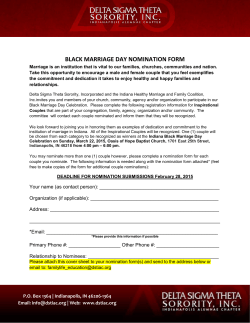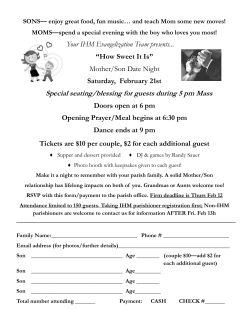
Couples and Resultants with Couples
Introduction to Statics .PDF Edition – Version 0.95 Unit 21 Couples and Resultants with Couples Helen Margaret Lester Plants Late Professor Emerita Wallace Starr Venable Emeritus Associate Professor West Virginia University, Morgantown, West Virginia © Copyright 2010 by Wallace Venable Conditions of Use This book, and related support materials, may be downloaded without charge for personal use from www.SecretsOfEngineering.net You may print one copy of this document for personal use. You may install a copy of this material on a computer or other electronic reader for personal use. Redistribution in any form is expressly prohibited. Unit 21 Couples and Resultants with Couples Frame 21-1 Introduction In the analysis of machines and machine parts the engineer often finds it necessary to represent a twisting or turning moment which acts on a body but is not associated with forces at the point of application. This unit will help you learn how to handle such situations through the use of couples. Turn to the next frame. Correct response to preceding frame No response Frame 21-2 Couples In mechanics a "couple" is composed of forces. If this use of the term couple is similar to everyday English, how many forces make up a couple? ______ Correct response to preceding frame two Frame 21-3 Review These two forces have the following characteristics: 1. (equal, unequal) magnitudes 2. (the same, different) inclinations 3. (the same, opposite) sense 4. (the same, parallel) lines of action Two forces of these characteristics are called ____________ and ________________ Correct response to preceding frame 1. equal 2. the same 3. opposite 4. parallel equal and opposite Frame 21-4 Couples The forces shown are an example of a couple F F 1 2 = 3i + 4j = -3i - 4j The forces which make up a couple are _______________ and ___________________ . Correct response to preceding frame equal and opposite (Or equivalent response) Frame 21-5 Couples A couple is composed of two equal and opposite, non-collinear forces. Which of the following show or describe couples? Correct response to preceding frame (a) and (f) Frame 21-6 Resultant Force Due to a Couple What is the resultant force on a body due to an applied couple? ______________ Correct response to preceding frame zero Frame 21-7 Moment of a Couple The forces which make up the couple shown below lie in the x-y plane and s is the distance between the lines of action. What is the moment of the couple about 1. Point A ? ___________________ 2. Point B ? ___________________ 3. Point C ? ___________________ 4. Any point on the line of action of one of the forces? ___________________ Correct response to preceding frame +sFk for all points on the lines of action Frame 21-8 Moment of a Couple Open your notebook to page 21-1 and complete the statement at the top of the page. Then use the figure to help you answer the following questions. Using vector products, write an expression for the moment of F1 about the general point (x, y, z) M1 = _______________________ Similarly, write an expression for the moment of F2 about the same point. M2 = _______________________ Correct response to preceding frame M1 = r1 } F1 M 2 = r 2 } F2 Record these on page 21-1 at (1) in your notebook. Frame 21-9 Moment of a Couple The total moment of the forces about the point is MT = [r1 } F1] + [r2 } F2] By definition F1 = -F2 so that the total moment may be rewritten MT = [r1 } _____ ] + [r2 } F2] Correct response to preceding frame MT = [r1 } (-F2)] + [r2 } F2] Frame 21-10 Moment of a Couple This equation can be shuffled to get MT = [r2 } F2] - [r1 } F2] Make use of the distributive property of vector products, [A + B] } C = [A } C] + [B } C] to obtain MT = ( __________ ) } F2 Correct response to preceding frame MT = (r2 - r1) } F2 Frame 21-11 Moment of a Couple (r2 – r1) = r12 on the drawing, thus MT = r12 } F2 which is the moment of force ______ about a point located on the line of action of ____________________ . Correct response to preceding frame F2 F1 Frame 21-12 Moment of a Couple Write the expression MT = (r2 - r1) } F2 = MT = r12 } F2 on page 21-1 of your notebook at (2) and read the theorem which we have just demonstrated. Correct response to preceding frame No response Frame 21-13 Moment of a Couple In each of the problems below calculate the moment of the couple about Point A. Correct response to preceding frame Frame 21-14 Transition The preceding frames have been devoted to the definition of a couple and to the computation of the moment of a couple. The next section will be devoted to the characteristics of couples and to various ways of representing them. Don't break yet unless it is absolutely necessary. Go to the next frame. Correct response to preceding frame No response Frame 21-15 Characteristics of a Couple The characteristics of a force are: $ $ $ magnitude direction point of application Place an X beside any characteristic of a force that you do not expect to be characteristic of a couple. Correct response to preceding frame point of application Frame 21-16 Characteristics of a Couple The characteristics of a couple are (1.) the magnitude of the moment (2.) the direction of the moment vector -- this includes both its line of action and its sense. Give the characteristics of the couple shown. Correct response to preceding frame magnitude 150 foot-pounds direction +j Frame 21-17 Characteristics of a Couple Another way of describing the direction of a couple is to give the slope of the plane in which the forces are applied and the sense of the rotation. The sketch shows a couple whose magnitude is ___________ applied in a _________________ plane with a _______________________ rotation. Correct response to preceding frame 180 N-m horizontal positive, or counterclockwise (Or equivalent response) Frame 21-18 Representation of Couples Since the forces which make up a couple have no resultant effect on the body except their moment, any other pair of forces which gives the same moment is equivalent. Which of the following pairs of forces form equivalent couples? Correct response to preceding frame (b), (c), and (d) are equivalent Frame 21-19 Transformations of a Couple Transformations of a couple are operations which may be performed on the couple without changing its characteristics. Which of the following are not valid transformations of the couple shown in (a) ? Correct response to preceding frame Transformations (d) and (f) are not valid (a), (b), (c) and (e) all show a couple of +20k N-m (d) shows a couple of 20j N-m (f) shows a couple of -20k N-m Frame 21-20 Transformations of a Couple The following operations may be performed without changing the characteristics of a couple. The couple may be 1. rotated in its plane 2. moved to a parallel position in its plane 3. moved to a parallel plane 4. recomposed into a different combination of force and distance provided the moment remains the same. Each sketch shows a transformed couple. Identify which of the above steps was used and write the number, or numbers, in the appropriate blank. Correct response to preceding frame (a) 3 (b) 1 (c) 1 and 4 Frame 21-21 Transformations of Couples Couples are equivalent if they have the same moment or, in other words, if one may be transformed into the other. Are the two couples below equivalent? If so, prove it by making use of the operations listed in the preceding frame. If not, change the second couple so that it is equivalent to the first. Correct response to preceding frame The couples are equivalent The steps may be taken in any order. Frame 21-22 Representation of Couples We often picture a couple as a curved arrow like this: Show and label on the sketch below 1. a clockwise moment of 25 ft-lb about the x axis 2. a counterclockwise moment of 60 ft-lb about the y axis Correct response to preceding frame Frame 21-23 Representation of Couples Suppose you were given a couple in this form: Which of these force pairs are equivalent to the couple above? Can a couple be resolved into a unique pair of forces? $ Yes $ No Correct response to preceding frame all are equivalent No Frame 21-24 Representation of Couples Use the new notation to show the couple caused by F1 and F2 on sketch (b). Correct response to preceding frame Frame 21-25 Characteristics of a Couple The direction of a couple is often given by describing the axis about which it would cause rotation and the sense of the rotation. The couple shown has a magnitude of ______________ and causes rotation about a ______________ axis in a _____________ direction. Correct response to preceding frame 350 ft-lb vertical axis positive, or counterclockwise Frame 21-26 Representation of a Couple Another common representation of a couple is by a vector arrow in the direction of the moment of a couple. Since a couple has no particular location such a vector can be shown anywhere so long as it is properly directed. In order to avoid the dire consequences of confusing forces and couples, the vector representing the couple is often drawn as an outlined arrow. Thus, a moment of 60k N-m might be shown as Draw a vector representation of a couple of -40i inch-pounds. Correct response to preceding frame (Or equivalent response) Frame 21-27 Representation of a Couple When a couple is represented as a vector the vector is drawn along or parallel to the axis about which the couple would cause rotation. The sense is determined by the right hand rule. Draw a vector representing the couple shown below. Correct response to preceding frame (Other locations are just as good.) Frame 21-28 Representation of a Couple Draw two other representations of the couple shown below. Correct response to preceding frame Frame 21-29 Recapitulation Sum up what you have learned so far on page 21-2 of your notebook. Correct response to preceding frame Frame 21-30 Transition The next sort of problem we will look at involves replacing a force in one location with an equal parallel force in another location plus a couple, without changing the resultant of the system. This is a strategy that is often used in the solution of problems in strength of materials since it enables one to do a better job of visualizing the effects of a loading. This will be the last section of this unit and will only take about 10 minutes. Go the next frame. Correct response to preceding frame No response Frame 21-31 Resolution of a Force into a Force and a Couple Two loadings are shown below. Are the force systems equivalent? $ Yes $ No Correct response to preceding frame Yes. The systems are equivalent since the addition of two equal, opposite collinear forces does not affect the resultant. Frame 21-32 Resolution of a Force into a Force and a Couple Figures A and B show (equivalent, non-equivalent) force systems. Figure B contains a couple. Circle the two forces which comprise it. Correct response to preceding frame equivalent Frame 21-33 Resolution of a Force into a Force and a Couple Are the two force systems shown equivalent? $ Yes $ No Correct response to preceding frame Yes Frame 21-34 Resolution of a Force into a Force and a Couple The sketches below show the steps in replacing a force through A with a force through B and a couple. What is the force through A ? ________________ What is the force through B ? ________________ What is the value of couple C ? ________________ Correct response to preceding frame FA = -30j lb FB = -30j lb C = +150k in-lb Frame 21-35 Resolution of a Force into a Force and a Couple The two systems shown above are equivalent. Point B is the mass center of the block. In loading (1) the 30 pound force will cause the block to tend to tip about an axis through the mass center. Does the 30 pound force in loading (2) tend to tip the body about B? $ Yes $ No What does tend to tip the body? ________________________________ Correct response to preceding frame No The couple Frame 21-36 Resolution of a Force into a Force and a Couple Replace the force at A with a force through C plus a couple by completing the sketches. Correct response to preceding frame Frame 21-37 Resolution of a Force into a Force and a Couple Do Problems 21-1 and 21-2 in your notebook. Correct response to preceding frame Frame 21-38 Summary That completes this unit. You now know how to define a couple, how to compute its moment, how to work simple problems which involve couples, and how to resolve a force into a force and a couple. In the next unit you will use these ideas to work more involved problems of the equilibrium of machine elements.
© Copyright 2025









